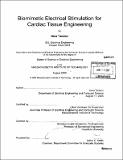| dc.contributor.advisor | Joel Voldman and Gordana Vunjak-Novakovic. | en_US |
| dc.contributor.author | Tandon, Nina | en_US |
| dc.contributor.other | Massachusetts Institute of Technology. Dept. of Electrical Engineering and Computer Science. | en_US |
| dc.date.accessioned | 2007-08-03T18:30:00Z | |
| dc.date.available | 2007-08-03T18:30:00Z | |
| dc.date.copyright | 2006 | en_US |
| dc.date.issued | 2006 | en_US |
| dc.identifier.uri | http://hdl.handle.net/1721.1/38323 | |
| dc.description | Thesis (S.M.)--Massachusetts Institute of Technology, Dept. of Electrical Engineering and Computer Science, 2006. | en_US |
| dc.description | Includes bibliographical references (leaves 66-69). | en_US |
| dc.description.abstract | A major challenge of tissue engineering is directing cells to establish the physiological structure and function of the tissue being replaced. Electrical stimulation has been used to induce synchronous contractions of cultured cardiac constructs. The hypothesis adopted for this study is that functional cardiac constructs can be engineered by "mimicking" the conditions present during cardiac development, and in particular, electrical stimulation using supra-threshold signals. For this Master's Thesis research, I have compared the material properties and charge-transfer characteristics at the electrode-electrolyte interface of various biocompatible materials, including carbon, stainless steel, titanium and titanium nitride, for use as electrodes in a biomimetic system for cardiac tissue engineering. I have also designed and implemented an electrical stimulator which is capable of modulating several important parameters of electrical stimulation, including stimulus amplitude and frequency. | en_US |
| dc.description.abstract | (cont.) In addition, I have built an experimental setup incorporating this electrical stimulator and used it for experiments with C2C12 mouse myoblast cells and neonatal rat cardiomyocytes. Lastly, I have analyzed cell morphology as well as functional performance of engineered tissue by assessing excitation thresholds and maximum capture rates. | en_US |
| dc.description.statementofresponsibility | by Nina Tandon. | en_US |
| dc.format.extent | 75 leaves | en_US |
| dc.language.iso | eng | en_US |
| dc.publisher | Massachusetts Institute of Technology | en_US |
| dc.rights | M.I.T. theses are protected by copyright. They may be viewed from this source for any purpose, but reproduction or distribution in any format is prohibited without written permission. See provided URL for inquiries about permission. | en_US |
| dc.rights.uri | http://dspace.mit.edu/handle/1721.1/7582 | |
| dc.subject | Electrical Engineering and Computer Science. | en_US |
| dc.title | Biomimetic electrical stimulation for cardiac tissue engineering | en_US |
| dc.type | Thesis | en_US |
| dc.description.degree | S.M. | en_US |
| dc.contributor.department | Massachusetts Institute of Technology. Department of Electrical Engineering and Computer Science | |
| dc.identifier.oclc | 154317688 | en_US |
